Natural fences that prioritize wildlife safety include native shrub barriers, living hedgerows, and stone walls with small animal crossings. You’ll create effective boundaries while providing habitat and food sources for local fauna. Consider low wire fences (under 42 inches) that allow deer to jump over and smaller animals to pass underneath. Water features can establish clear property lines while supporting diverse ecosystems. These wildlife-friendly options maintain property boundaries without disrupting natural migration patterns and movement corridors.
Native Shrub Barriers That Allow Wildlife Passage

While traditional fencing may create hazardous barriers for local wildlife, native shrub barriers offer a thoughtful alternative that balances property boundaries with ecological needs.
Native plantings redefine boundaries, turning potential wildlife hazards into thriving ecological corridors.
You’ll find that species like elderberry and serviceberry not only define your property line but also provide essential habitat and food sources for local fauna.
When designing wildlife-friendly fencing with native shrubs, be sure to space plantings adequately.
This strategic spacing allows animals to navigate through the barrier without risk of entanglement.
Most native shrubs naturally grow in patterns that permit creatures to crawl underneath or leap over them safely.
Designing Stone Walls With Animal Crossings
Because traditional stone walls can create barriers in wildlife corridors, thoughtfully designed crossings offer essential pathways for local fauna. When building your stone wall, incorporate 6-12 inch gaps at regular intervals to allow smaller animals like rabbits and foxes to pass through safely while still deterring larger species.
Use locally-sourced stones that blend with the surrounding landscape, providing natural shelter and camouflage for wildlife. These materials create a more authentic barrier that supports rather than disrupts the ecosystem.
Don’t forget to maintain your wall regularly by clearing vegetation that might block animal passages. Complement your stone structure with diverse native plantings nearby to enhance biodiversity.
This combination creates an effective boundary for human activities while facilitating wildlife movement between habitats—maintaining essential ecological connectivity in your landscape.
Living Hedgerows as Habitat and Boundary

You’ll find that choosing diverse native plants for your hedgerow creates a thriving wildlife corridor while establishing a natural property boundary.
These living fences offer year-round shelter and food sources, connecting fragmented habitats for birds, insects, and small mammals.
Regular seasonal maintenance, including selective pruning and occasional replanting, guarantees your hedgerow continues to provide maximum wildlife benefits while maintaining its structural integrity.
Native Plants Selection
When designing living hedgerows as natural boundaries, choosing native plants creates wildlife habitats that serve multiple ecological functions. These wildlife-friendly options are naturally adapted to your local soil and climate conditions, ensuring better growth and resilience without excessive maintenance.
Native plants support local ecosystems by providing familiar food sources and shelter for indigenous wildlife. You’ll want to incorporate various heights and growth patterns to create layered habitats that attract diverse species—from ground-dwelling mammals to nesting birds. This structural diversity maximizes the ecological value of your living fence.
Your selection of native species will establish corridors that facilitate safe movement for small animals and pollinators across the landscape. Additionally, these natural barriers function as effective windbreaks and noise buffers, creating a more pleasant environment for both wildlife and your household.
Wildlife Corridor Benefits
Beyond the thoughtful selection of native plants lies their transformative impact as wildlife corridors. When you establish living hedgerows on your property, you’re creating safe passages that allow wildlife to jump between habitats without risking exposure to predators or human threats.
Unlike traditional fences that obstruct natural migration patterns, hedgerows facilitate movement while providing food and shelter. You’ll notice increased biodiversity as these natural boundaries filter water runoff, prevent soil erosion, and retain essential moisture.
Your living fence becomes a multifunctional ecosystem – simultaneously defining property lines while supporting local wildlife populations. Birds nest in branches, small mammals find protection in dense undergrowth, and pollinators thrive among diverse flowering plants.
Seasonal Growth Maintenance
Commitment to regular maintenance transforms living hedgerows from simple green barriers into thriving wildlife sanctuaries.
When you trim your hedgerows seasonally, you’ll guarantee they remain passable corridors for wildlife movement while still providing adequate shelter and food resources.
Your maintenance schedule should prioritize:
- Trimming after nesting season to avoid disturbing breeding wildlife
- Maintaining varied heights and densities to support diverse species
- Cutting in sections rather than all at once to preserve habitat continuity
Water Features as Natural Wildlife-Friendly Borders
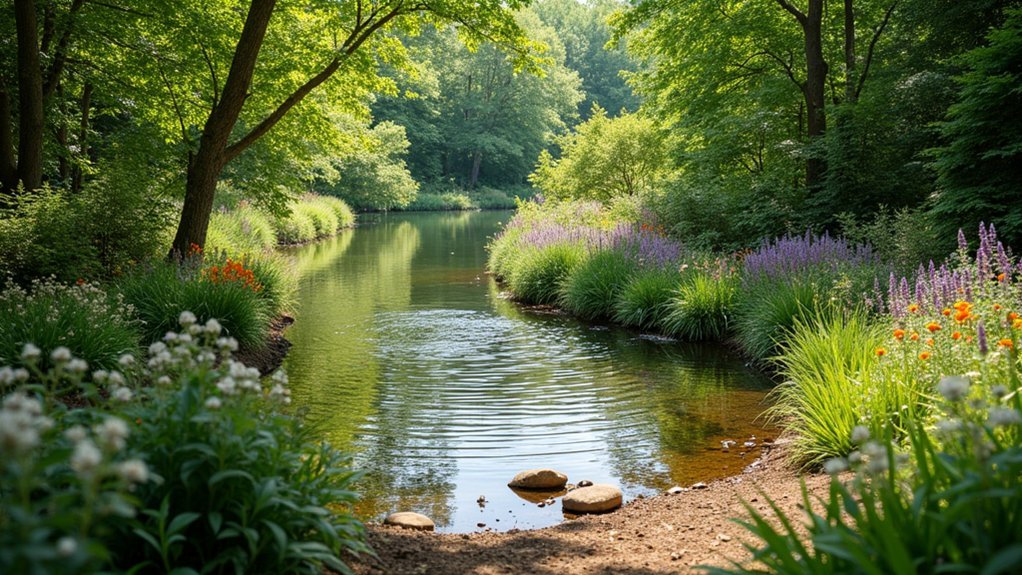
Although traditional fencing often disrupts wildlife corridors, water features offer a natural alternative that simultaneously defines property boundaries and supports thriving ecosystems.
When you install ponds or streams along your property lines, you’re creating habitats that attract diverse wildlife while establishing clear boundaries.
These water features function as effective barriers for larger animals yet provide essential resources for birds, amphibians, and insects.
Consider incorporating strategic shallow areas or gaps to allow smaller creatures safe passage between habitats. Water borders naturally deter many land predators, offering protection for vulnerable wildlife and livestock without harmful physical barriers.
Enhance these aquatic boundaries by planting native water-loving vegetation around the edges.
This additional coverage provides shelter and food sources, further supporting local biodiversity while maintaining your property’s distinct perimeter.
Balancing Security Needs With Wildlife Movement
When establishing property boundaries, you’ll often face the challenge of maintaining security while allowing wildlife to move freely. Wildlife-friendly wire fences under 42 inches tall provide protection while allowing deer to jump over and smaller animals to crawl underneath.
Balancing security with wildlife movement is possible with low wire fences that protect your property while respecting natural animal pathways.
For enhanced security without hindering animal movement, consider:
- Motion-sensing lights and cameras that detect threats without creating physical barriers
- Natural deterrents like thorny hedges that double as wildlife habitat while discouraging intruders
- Well-trained dogs that alert you to human presence while peacefully coexisting with local wildlife
Remember that community-based security approaches work effectively alongside wildlife-friendly boundaries.
Seasonal Maintenance for Natural Wildlife Corridors
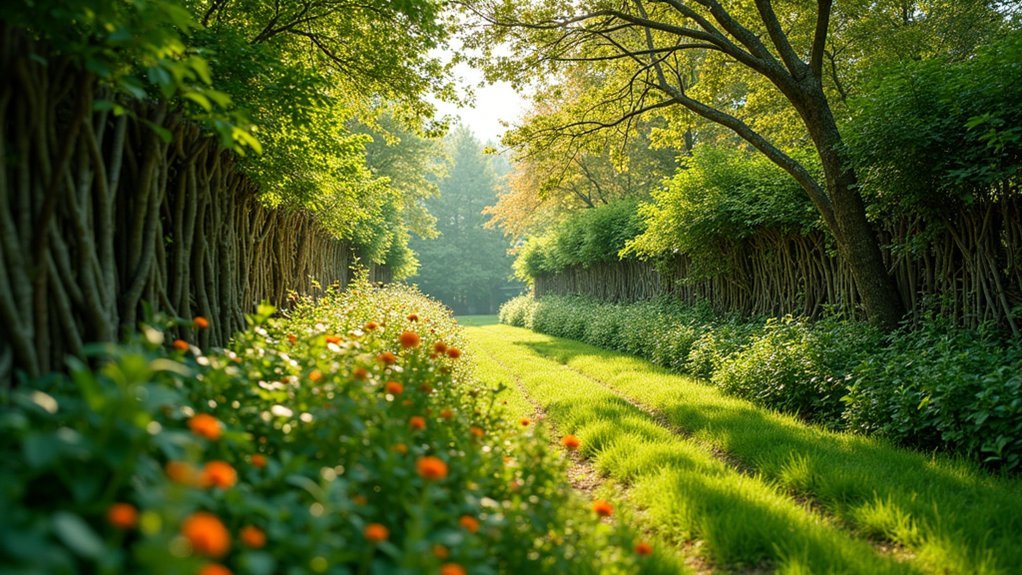
Maintain brush piles in winter by ensuring they’re positioned away from corridors while still providing shelter for hibernating wildlife.
Clear migration routes in spring before birds and other animals return, removing fallen debris and repairing any damage from winter storms.
During summer’s peak growth period, you’ll need to monitor vegetation weekly, trimming back excessive growth that might block wildlife movement while preserving essential shade and food sources.
Winter Brush Pile Management
Three critical elements define effective winter brush pile management: structure, placement, and maintenance. Your brush piles serve as essential wildlife shelters during harsh months, preventing injury from predators and extreme weather conditions.
Inspect your piles regularly to maintain their habitat value:
- Replenish with natural debris like fallen branches and leaves to preserve structural integrity.
- Create multiple piles across your property to enhance connectivity for wildlife movement.
- Remove any invasive species that could disrupt native populations.
Avoid using chemicals or pesticides near these shelters, as they’ll harm beneficial creatures.
Spring Migration Clearways
As spring awakens the landscape, migratory wildlife depends on clear, unobstructed pathways for safe seasonal journeys. You’ll need to maintain spring migration clearways of at least 20 feet wide to accommodate both large mammals and smaller creatures.
| Clearway Type | Maintenance Needed | Timing |
|---|---|---|
| Forest corridors | Trim overhanging branches | Early spring |
| Field passages | Remove temporary fencing | Pre-migration period |
| Wetland routes | Clear debris from waterways | After last frost |
Regular inspections guarantee wildlife-friendly passages remain accessible when animals need them most. Schedule your maintenance to coincide with local migration patterns, as timing varies by species. Don’t forget to coordinate with neighbors to implement community guidelines regarding temporary structures during peak migration seasons—this collaborative approach creates safer, continuous pathways for traveling wildlife.
Summer Growth Monitoring
Once migratory pathways are established in spring, your attention must shift to managing summer’s vigorous growth.
Regular monitoring guarantees your natural fences provide ideal wildlife habitat while maintaining clear passage corridors. Check vegetation height and density weekly, removing any obstructions that might impede animal movement.
Combat invasive species promptly as they compete with native plants that wildlife depends on.
You’ll need to:
- Document wildlife activity patterns to track fence effectiveness
- Inspect plants for disease or pest issues that could compromise the barrier
- Selectively trim overgrown sections while preserving essential cover
These summer maintenance practices create a balance between providing protective habitat and guaranteeing unobstructed movement.
The data you collect will prove invaluable for improving your wildlife-friendly fences in subsequent seasons, creating increasingly effective natural corridors over time.
Frequently Asked Questions
What Is the Best Fence to Keep Wild Animals Out?
You’ll find post-and-rail fences most effective for keeping wild animals out. They’re highly visible, allowing animals to safely jump over or crawl under without injury while still creating a barrier for larger creatures.
What Is Wildlife Friendly Fencing?
Wildlife-friendly fencing allows animals to move safely through landscapes while still containing livestock. You’ll find these fences have smooth wires, appropriate spacing, lower heights, and visibility markers to prevent entanglement, injury, or blocking migration routes.
What Fencing Is Nature Friendly?
Nature-friendly fencing includes post-and-rail designs, smooth wire fences under 42 inches high with 16-inch ground clearance, living barriers made of native plants, and worm fences. You’ll also benefit from adding visibility markers to any wire fencing.
Will Deer Jump a 7 Foot Fence?
Yes, deer can jump a 7-foot fence if they’re motivated enough. You’ll need at least 8 feet for reliable protection, or consider adding angled extensions to make the barrier more difficult to clear.
In Summary
When you choose natural fencing options, you’re creating boundaries that protect both your property and local wildlife. Remember to incorporate wildlife passages, select native species, and maintain your living barriers seasonally. By thoughtfully designing stone walls, hedgerows, or water features, you’ll establish effective borders that don’t disrupt natural movement patterns. Your eco-friendly approach creates harmony between human needs and wildlife conservation—proving security and sustainability can coexist beautifully.

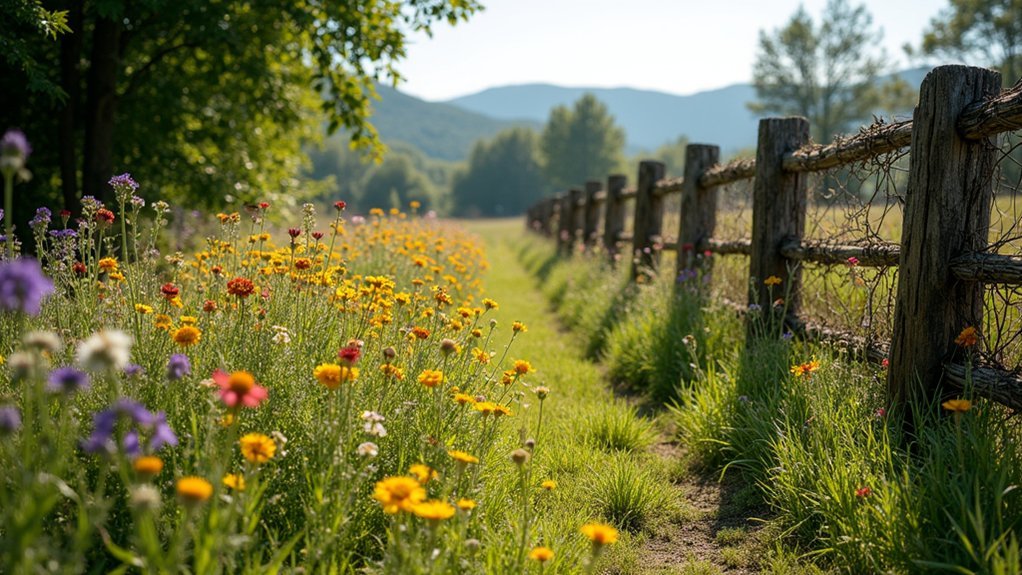

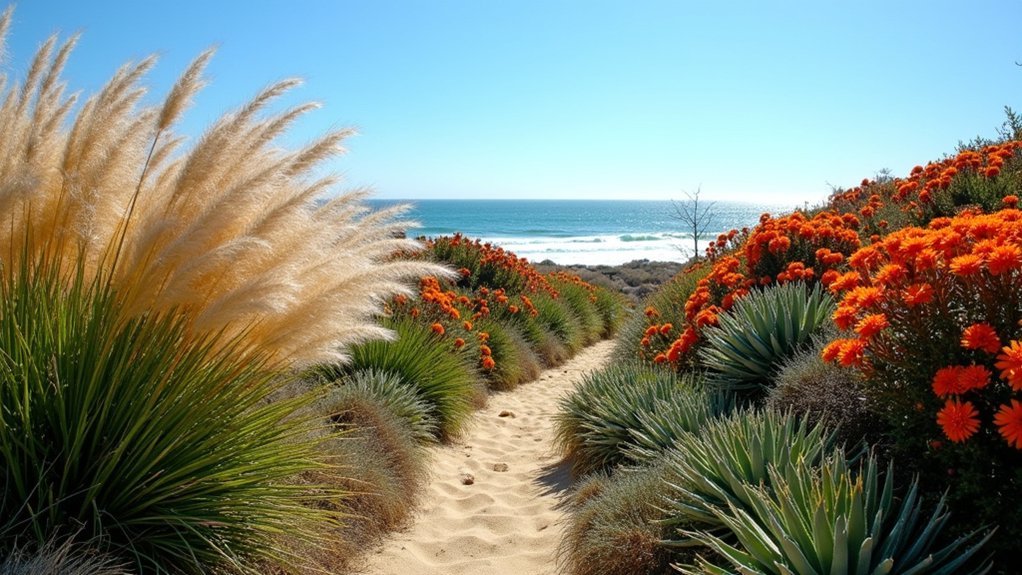
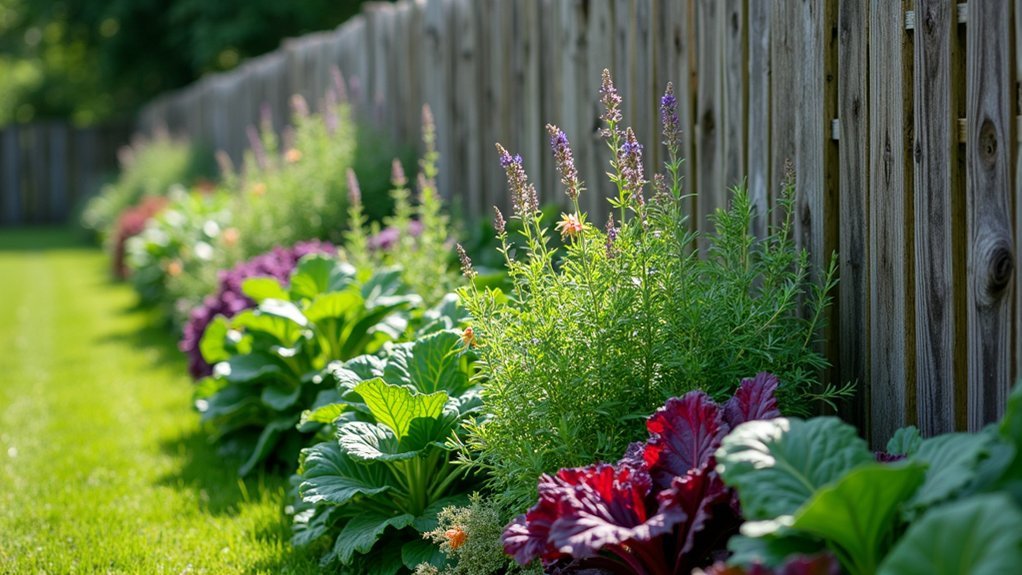
Leave a Reply